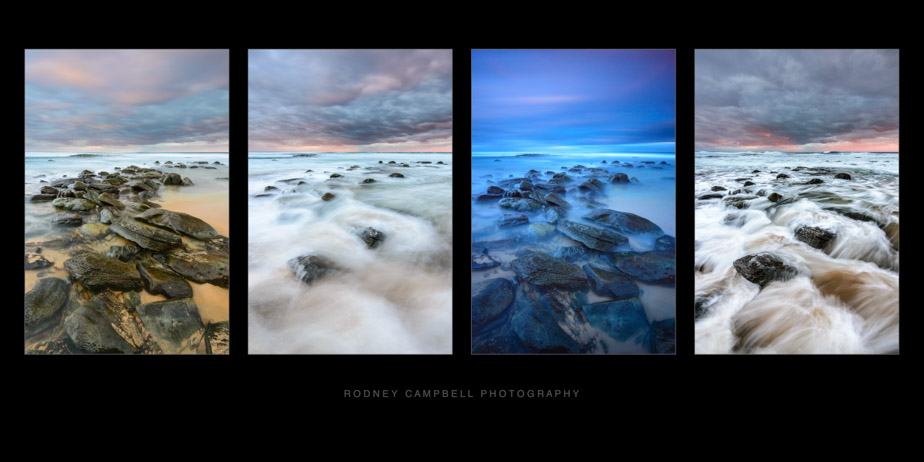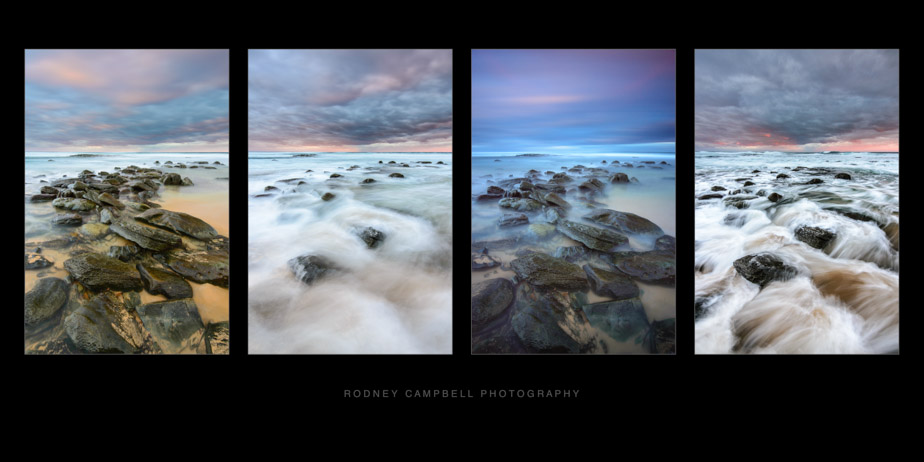Seconds Count...
Mj's wish is my command... or something like that... 
What a difference a few seconds can make to a seascape composition...
I've created a quadriptych of four shots taken in the minutes leading up to sunset to highlight how changing a few variables through intelligent use of camera functions and tools along with appropriate timing of when to start the capture can dramatically alter the final result for the same exact scene.
The images all have the exact same location, framing and composition; same focal length and were taken within minutes of each other - the difference is in waiting for and timing of the moment to take the photo based on the movement of the water and predicting where it will go during the exposure interval and adjusting other camera functions (mostly related to the length of time for the exposure - in this case the exposures range from half a second through to 240 seconds at the extremes) to get four very different looks.
Seconds Count

The first a medium fifteen (15) second exposure timed for when there was minimal water movement and the water has run out - the effect of the shutter time is a softer dreamy look to the clouds and sky and what water is moving slowly turns to glass (where the polariser cuts through) or the faster moving stuff in the distance to milk
The second is a shorter exposure (but still six (6) seconds) timed for when there was maximum water movement with a large body of water moving through the scene and across the rocks. The shorter shutter time also results in less time for motion of the sky and water so that the moving components have a more stringy textured look where we can actually see the path of motion rather than it turning to a misty blur
The third a very very long exposure created using the Lee BigStopper. This resulted in a four minute exposure (using the Lee 0.6 Hard Grad ND, Heliopan CPL and the Lee BigStopper) for a really dreamy seaside look where all moving texture is gone and we have sharply defined static objects sitting in a sea of soft tonal blur from the moving components
The last at the other end of the spectrum is a relatively short exposure (half a second) designed to really highlight the texture of the moving water and is timed for maximum impact (after most of the wave has crashed over the stones and we're just seeing the curving rippling water flow and backwash)
What a difference a few seconds can make to a seascape composition...
I've created a quadriptych of four shots taken in the minutes leading up to sunset to highlight how changing a few variables through intelligent use of camera functions and tools along with appropriate timing of when to start the capture can dramatically alter the final result for the same exact scene.
The images all have the exact same location, framing and composition; same focal length and were taken within minutes of each other - the difference is in waiting for and timing of the moment to take the photo based on the movement of the water and predicting where it will go during the exposure interval and adjusting other camera functions (mostly related to the length of time for the exposure - in this case the exposures range from half a second through to 240 seconds at the extremes) to get four very different looks.
Seconds Count

The first a medium fifteen (15) second exposure timed for when there was minimal water movement and the water has run out - the effect of the shutter time is a softer dreamy look to the clouds and sky and what water is moving slowly turns to glass (where the polariser cuts through) or the faster moving stuff in the distance to milk
The second is a shorter exposure (but still six (6) seconds) timed for when there was maximum water movement with a large body of water moving through the scene and across the rocks. The shorter shutter time also results in less time for motion of the sky and water so that the moving components have a more stringy textured look where we can actually see the path of motion rather than it turning to a misty blur
The third a very very long exposure created using the Lee BigStopper. This resulted in a four minute exposure (using the Lee 0.6 Hard Grad ND, Heliopan CPL and the Lee BigStopper) for a really dreamy seaside look where all moving texture is gone and we have sharply defined static objects sitting in a sea of soft tonal blur from the moving components
The last at the other end of the spectrum is a relatively short exposure (half a second) designed to really highlight the texture of the moving water and is timed for maximum impact (after most of the wave has crashed over the stones and we're just seeing the curving rippling water flow and backwash)
